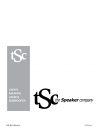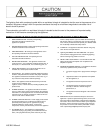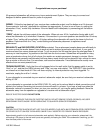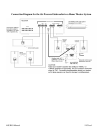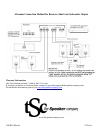ASUB10 Manual 1107ver1
Congratulations on your purchase!
tSc powered subwoofers will enhance any home entertainment System. They are easy to connect and
designed to deliver powerful bass for years of enjoyment
WIRING - Follow the top drawing if your receiver has a subwoofer output, and the bottom one if it does not.
Some receiver’s “sub outs” attenuate the mid-bass too aggressively. If yours is one of them, try setting the
subwoofers “Freq.” control fully clockwise. If the mid-bass is still inadequate, try connecting per the bottom
drawing.
“FREQ” adjusts the mid-bass output of the subwoofer. When set near 40 Hz, localization (being able to tell
where the subwoofer is) is minimized. However, if the woofers in your main speakers are smaller than 8 inches,
a higher “Freq.” setting will sound better. At higher settings the subwoofer will need to be closer to the front
speakers. Experiment with the “Freq.” control setting and subwoofer placement to optimize overall
performance.
RELIABILITY and SUB WOOFER LOCATION are related. Corner placement couples bass more efficiently to
the room so that the woofer doesn’t have to work as hard to achieve a particular sound level, If your goal is
maximum bass then corner placement is best. Try all corners to find the one that gives the strongest bass. If
accuracy is most important, try positions a few feet from the front corners. Subwoofers will operate for many
years at moderate volume, but at full volume, the woofer can sustain permanent damage in minutes. Movie
sound effects are generally well tolerated, but bass heavy music should not be played at high volume for more
than a minute or two at a time. For more bass, add a second subwoofer. Two subwoofers are usually more
effective than one more powerful one.
TROUBLESHOOTING - Verify that the unit is plugged into a live wall outlet, that the power switch is set to
“Auto” or “on”, and that the GAIN (volume) and “Freq.” are near mid-rotation. The “PWR/PRT” light should be
on unless the unit has timed off. If the unit does not play, its internal protection may have triggered. To
reactivate, unplug the unit for 1 minute.
If your subwoofer is connected via your receiver’s subwoofer output, be sure that your receiver’s subwoofer
setting Is” ON”.
If your subwoofer is connected via the HIGH LEVEL IN, verify red-to-red and black-to-black connections at all
points in the hookup. Reversing just one set of wires will result in no bass. If you hear a loud hum when the
subwoofer volume is increased, or when you turn your receiver off, you may be getting feedback. Move the
subwoofer away from the speakers or upgrade to a receiver with a subwoofer output.
RISK OF ELECTRIC SHOCK DO NOT OPEN
CAUTION: TO REDUCE THE RISK OF ELECTRIC SHOCK, DO NOT REMOVE COVER (OR BACK). NO USER
SERVICEABLE PARTS INSIDE. REFER SERVICING TO QUALIFIED SERVICE PERSONNEL.
CAUTION
PREVENT ELECTRIC SHOCK DO NOT USE THIS (POLARIZED) PLUG WITH AN EXTENSION CORD, RECEPTACLE
OR OTHER OUTLET UNLESS THE BLADES CAN BE FULLY INSERTED TO PREVENT BLADE EXPOSURE.
Approximately one-third of all returned subwoofers work perfectly. Before returning your subwoofer, please test it by
connecting a CD player to the low-level inputs and gradually increasing the GAIN. If the subwoofer is working, you will
hear the bass portion of the music.



